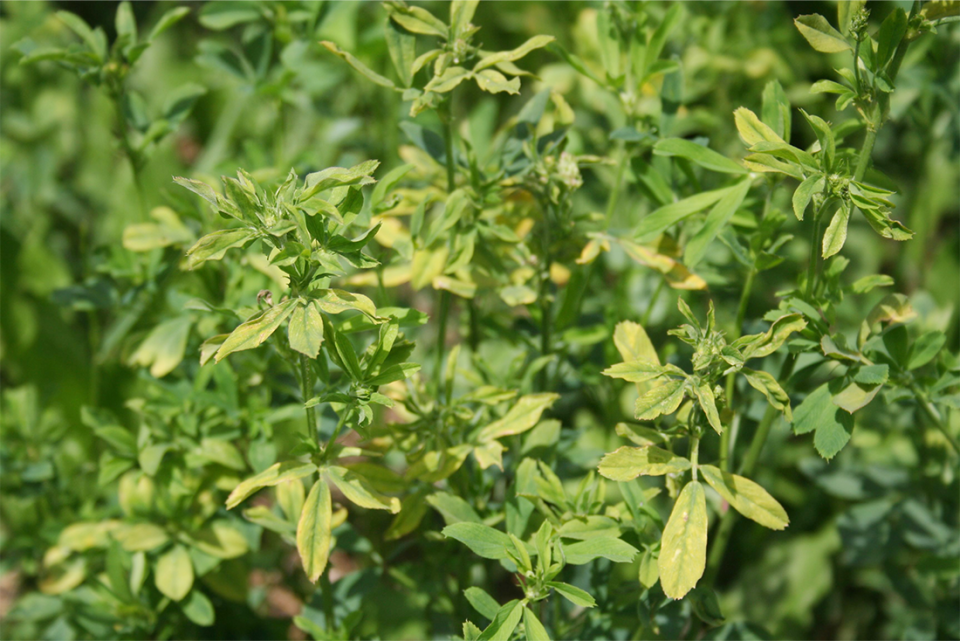
Pasture and Forage Minute: Drought-stunted Alfalfa Options, Bluegrass Control
Controlling Bluegrass in Irrigated Alfalfa
Bluegrass can be a common weed in irrigated alfalfa lowering forage quality and shortening stand longevity. Thankfully, these pesky plants can be controlled by maintaining thick alfalfa stands, properly managing irrigation and/or using herbicides (as a last resort).
High-density alfalfa stands can effectively compete with bluegrass for sunlight, moisture and nutrients. However, it is important to time irrigation so the upper several inches of fields are dry at harvest. Then, delay irrigation until significant alfalfa regrowth is initiated. Unlike alfalfa, which has a deep root system, bluegrass is shallow rooted and will not compete well with the alfalfa if the topsoil is dry. Conversely, early irrigation (following harvest) may allow bluegrass to out-compete the alfalfa for available surface moisture, since bluegrass basal leaves help it grow more rapidly after the alfalfa is cut. Once alfalfa regains some regrowth, it will compete well with the bluegrass.
If stands are thick and water management is adequate, then labeled herbicides like Select Max®/Arrow®, Poast®, Velpar®, or Roundup WeatherMax® might be cost effective to weaken or kill grassy weeds like bluegrass. Apply any one of these immediately after harvest. Glyphosate herbicides can be used on Round-up Ready® alfalfa fields. For bluegrass and annual grasses like foxtail and crabgrass control, Select Max® and Arrow® have the highest rated control and is safe for your alfalfa.
Bluegrass is a problem in many irrigated alfalfa fields, but it doesn’t need to be. Using proper management, you can effectively control it.
Livestock Water Needs on Pasture
As summertime temperatures begin to heat up and cattle are on pasture, it’s important to make sure there is adequate water for livestock. How much do cattle need and where should it come from?
The water requirements for cattle depend on their size, class and environmental conditions. High humidity and greater temperatures also increase water demand. A University of Georgia study lists water requirements for days when the daily high temperature is 90°F. With these conditions, growing or lactating animals need two gallons of water per 100 pounds of body weight. This means a 1,400-pound, lactating cow will need close to 28 gallons of water daily with 90°F daily highs. If the calves are 250 pounds, they will need about five gallons. Again, some of the water will come from grazed forage. Make sure water tanks or water points are accessible for smaller calves.
Having fresh, clean water should also be a priority. With dry conditions this year in many parts of Nebraska, water quality from water sources such as dugouts or ponds and dams may not be ideal. The ability to have water close by should also be a goal, although sometimes it’s simply not possible. More water locations can help meet the water demand but could also help grazing distribution too. Cattle will receive some of their daily water requirements when they are consuming high moisture feedstuffs, such as fresh forage, when grazing pasture, silages or green chopped feeds. Feeds that are high-energy increase the water requirement.
Keep an eye on water this summer and make sure livestock have enough, good quality water available.
Drought-stunted Alfalfa — Cut or Leave
While some parts of Nebraska have caught precipitation recently, some areas are still dealing with significant drought. When drought stress causes dryland alfalfa stands stop growing, what should you do?
Many producers who still need a rain have dryland alfalfa fields with plants six to 12 inches tall and getting more and more purple by the day. When faced with short alfalfa stands, what should we do — hay it, shred it, graze it or just leave it?
First, the good news: While it stays dry, you can do whatever you feel like doing and you aren't likely to hurt your alfalfa. The bad news is that if it stays dry, you can't do anything good for it either.
As your alfalfa continues to just sit there dormant, it will slowly lose feed value and tonnage due to continued maturation, as well as leaf loss from insect feeding, diseases and simple old age. If you choose to harvest as-is, you probably need a yield of at least one-half ton per acre to justify the fuel, labor and other expenses involved with harvesting hay.
Grazing might be relatively cheap in terms of out-of-pocket costs if you already have portable electric fence and don't need to spend much money to transport cattle or water. Plus, dry, bloomed-out alfalfa has a pretty low risk for bloat — not foolproof, but common-sense animal husbandry should enable you to graze safely.
If you can't graze and can't justify cutting hay, it's probably best to just leave it alone. Shredding or haying will give you a cleaner, higher quality hay once your alfalfa does receive enough rain for regrowth. Removing the dormant plant will result in a bit faster regrowth, but plants also will regrow following sufficient rain without cutting. In most cases, it's not worth the cost and time involved to shred, clip or harvest low-yielding hay.
Pick the option best for you and pray for rain.
Online Master of Science in Agronomy
With a focus on industry applications and research, the online program is designed with maximum flexibility for today's working professionals.
